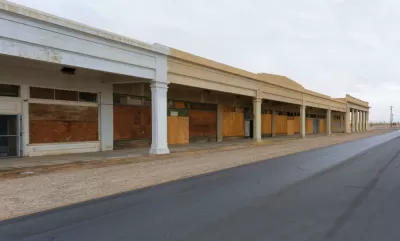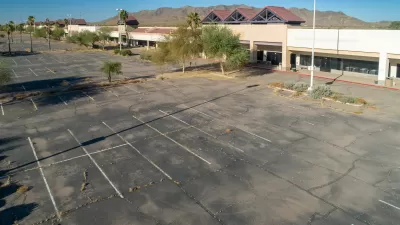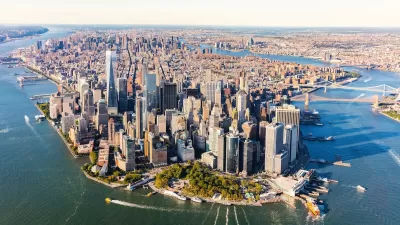The American strip mall may be a dying breed of commercial development, but could the buildings serve a new use as sustainable housing?

“Urban designer Peter Calthorpe has a plan for the shuttered and financially troubled strip malls that dot the suburban landscape: Convert the malls into housing that would be part of green communities where people could be closer to their jobs and get out of their cars.” As Jacques Leslie writes for Yale Environment 360, Calthorpe, in an interview, points out that “The idea of subdivisions for all was based on nuclear families, but now they represent just 24 percent of households in America. So we’re ready on many, many levels for more urban living — urban in the best, not the worst, sense.”
According to Calthorpe, “We’ve overbuilt single-family homes, and we need more multi-family housing. It turns out, especially now, after COVID, that strip commercial land is completely underutilized.”
“There is a large range of housing types that are appropriate, varying by site size, market, and construction costs. At the low-density end are live/work townhomes with small offices or flex space at the ground floor. Most common are “podium apartments” which have a concrete first floor containing parking and shops lining the streets with multi-story apartments or condos above. In areas well-served by transit, mid-rise buildings with ground floor shops and below-grade parking are possible.”
Calthorpe says that “If the strip commercial land in just the Bay Area and Los Angeles County were 100 percent redeveloped, that could provide 2.6 million units”—more than the estimated 2.5 million units California needs to eliminate its housing shortage.
Calthorpe acknowledges that housing production is “partly a zoning battle,” saying “local government is not a particularly advantageous place to argue for higher densities and infill. It needs state legislation enabling ‘as of right’ zoning [which overrides local obstacles such as design review boards].” Less restrictive zoning could pave the way for more innovative adaptive reuse, like the redevelopment of strip malls.
FULL STORY: How Ailing Strip Malls Could Be a Green Fix for U.S. Housing Crisis

Maui's Vacation Rental Debate Turns Ugly
Verbal attacks, misinformation campaigns and fistfights plague a high-stakes debate to convert thousands of vacation rentals into long-term housing.

Planetizen Federal Action Tracker
A weekly monitor of how Trump’s orders and actions are impacting planners and planning in America.

San Francisco Suspends Traffic Calming Amidst Record Deaths
Citing “a challenging fiscal landscape,” the city will cease the program on the heels of 42 traffic deaths, including 24 pedestrians.

Defunct Pittsburgh Power Plant to Become Residential Tower
A decommissioned steam heat plant will be redeveloped into almost 100 affordable housing units.

Trump Prompts Restructuring of Transportation Research Board in “Unprecedented Overreach”
The TRB has eliminated more than half of its committees including those focused on climate, equity, and cities.

Amtrak Rolls Out New Orleans to Alabama “Mardi Gras” Train
The new service will operate morning and evening departures between Mobile and New Orleans.
Urban Design for Planners 1: Software Tools
This six-course series explores essential urban design concepts using open source software and equips planners with the tools they need to participate fully in the urban design process.
Planning for Universal Design
Learn the tools for implementing Universal Design in planning regulations.
Heyer Gruel & Associates PA
JM Goldson LLC
Custer County Colorado
City of Camden Redevelopment Agency
City of Astoria
Transportation Research & Education Center (TREC) at Portland State University
Jefferson Parish Government
Camden Redevelopment Agency
City of Claremont





























